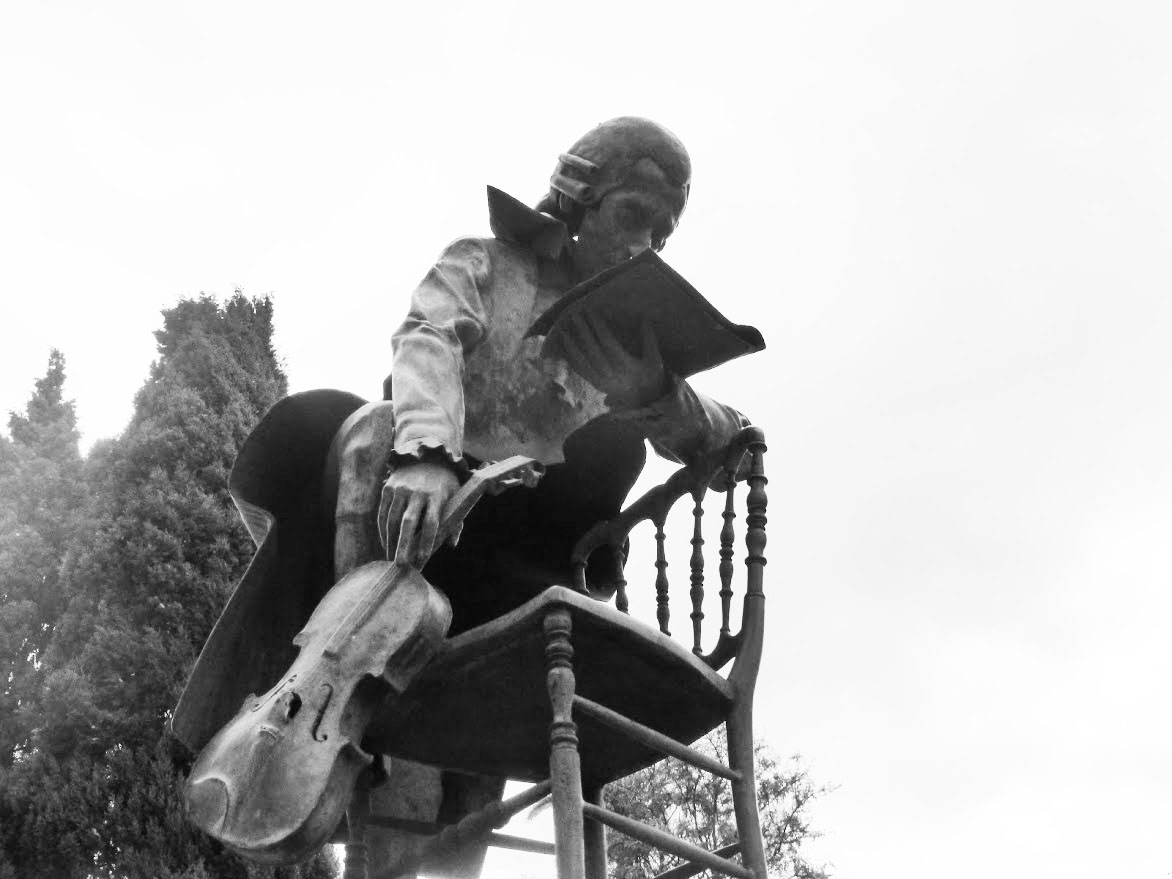
Once, while still in the Soviet Union, I took part in a round table discussion on the subject of upbringing, education and health. Opposite me sat a very prim and proper elderly gentleman. He gave the impression of a top official, and by his look alone made sure he kept a good distance between himself and the others at the meeting. I later discovered he was the director of the Institute of Pediatrics and a member of the Academy of Medical Sciences. We were discussing upbringing and the development of a child’s creative potential. The Academician bridled. “I don’t quite understand what we’re talking about”, he said, indicating by his expression and his tone that it was not he who did not understand us, but rather that it was we who didn’t understand what we were talking about. “What creativity? A man has to carry out his duties in his working time. What’s creativity got to do with it?” The discussion continued, however, until one of the participants showed a lack of caution and used the expression “creative ecstasy” to characterise the climactic peaking of all a person’s spiritual powers during the creative act. At this the Academician could restrain himself no longer. “Well, this is far beyond the frontiers…” He probably wanted to say “beyond the frontiers of our understanding” or “the frontiers of common sense”, but instead just spluttered into silence. So I asked him, gently, naively: “But why does it have to be beyond our frontiers? It does sometimes happen here, too, in the USSR.”
The instinctive hatred for creativity shown by a bureaucrat – a bureaucrat by nature, not the position he occupies – is natural and understandable. Creativity cannot be regimented, it cannot be managed (artists themselves are not even very good at it, let alone administrators), it cannot be included as part of a production plan or timetabled like a meeting for a particular time during the working hours. Insusceptible to regulation it may be, but creativity nonetheless has a serious influence on the activity not only of the creator himself, but also of a large collective, and sometimes even of an international professional community, and by doing so calls into question the authority and prestige of the administrator. What else can we expect from a bureaucrat in this situation, other than class hatred?
At about the same time I was involved in another discussion on the question of creativity at the popular science magazine Knowledge is Power. The session was chaired by Ivan T. Frolov, a very influential member of the Academy of Sciences and editor of the periodical Communist. When I waxed lyrical about creativity as the driving force of progress and the guarantor of individual health as well (since search activity, which so much of this book is about, is manifested in its purest form in creativity), Ivan Timofeyevich exclaimed: “Where is all this leading to? What is society going to do with all these creators? Who will be left to do an honest day’s work?” ( Remember the words about a man “carrying out his duties in his working time”? Was there some of kind of conspiracy amongst Soviet academicians against creativity?! ) And though I was somewhat taken aback by this rebuke from no less an authority than the Communist Party Central Committee’s tame philosopher, I still tried to protest and explained that a person who worked without any creative impulse would eventually lose respect both for himself and his work, and without such respect, without a sense of personal dignity, no work, not even the most repetitive, could be done well. Because we are not robots, our intelligence is not artificial, and the results of our activities depend on our self-perception, and the creative process has a highly beneficial effect on that. Naturally, I failed to convince the Academician. When logic is in contradiction with personal and clan interests, logic always loses.
What makes creativity such a special kind of activity? In an earlier chapter I described the way the right hemisphere creates a polysemantic context by way of ‘grabbing’ a huge number of connections and interactions between objects and phenomena, connections which cannot always be put in a logical order and which often simply contradict each other when placed within the confines of formal logic. Just try providing a coherent explanation of your relationship with a person who means something to you, a person who you both admire and envy at the same time, and your feeling of inner protest at experiencing both these emotions, and attraction, and repulsion. You can write down a recipe for a Chinese sweet and sour dish that is both clear and detailed, but the sweet and sour emotional relationship of one person with another cannot be explained in words without serious loss (except perhaps in verse by a poet of the calibre of Boris Pasternak, but that is not an explanation). And this is so because the foundations of complex emotional relationships, which are polysemantic by their nature, are formed from intersecting and contradictory connections.
By some miracle the right hemisphere interprets them all, forging a unique alloy out of them. And since this concerns not just interpersonal relationships, but all phenomena of reality, then it is the right hemisphere, its ability to create a polysemantic context, that enables the emergence of new connections between phenomena and their integration with previous experience, which is what creative inspiration is essentially about.
In this context it is interesting to note a finding, which has come out of many studies, that there is a strong correlation between creative talent and a sense of humour. A good joke, paradox or anecdote always combines two, sometimes mutually exclusive, meanings.
These theoretical assertions find support from analysis of the psychological methods used to investigate creative ability. The best known is the Guilford test. A subject is given a list of everyday items (or pictures of them) such as an iron, a coat hanger, a frying pan etc., and he is asked to describe every conceivable use he can think of for the items besides their regular purpose. The more variants the subjects suggests, and the more unusual and non-standard they are, the higher the score for creative potential. Sometimes life itself involves a spontaneous application of the Guilford test. The story is told of a Soviet citizen on a trip to Paris who couldn’t go to a café and had no money for a frying pan, so he cooked himself some eggs on the upturned base of an electric iron.
But what does the Guilford test actually reveal? It reveals an individual’s ability to break free from stereotype, from monosematic context (“an iron is an appliance for pressing laundry”, “a frying pan is needed to cook eggs”), from single connections linking two objects, and move to multiple connections of the given object to many others, in other words to the creation of polysemantic context. On one occasion Vladimir Raykov carried out the Guilford test during hypnosis. It was suggested to the subjects that they were outstandingly gifted creative people. Tested beforehand under normal conditions, these subjects were mediocre performers at best, naming 2 or 3 uses for each object. During hypnosis, they not only came up with more uses, but there was a qualitative change as well. A subject would leave out those uses he had suggested in his normal state. When the tester asked why he hadn’t thought of such-and-such a simple use, one which he had named the first time round, the subject would answer: “That’s far too obvious! Why would I want to give you such a banal answer?”
This experiment confirms not only that during hypnosis the possibilities for right-hemisphere thinking are expanded, but also that when it is suggested to a person that he is creative, it changes his self-esteem and self-perception. The perception of oneself as a creative person is the most important component of the creative act. This does not in any way mean a lack of criticism towards the results of one’s own activity. On the contrary, truly creative individuals are highly self-critical. But there is one important condition: this self-criticism appears only after the insight, after the inspiration, when the new piece is finished, not during its creation. Criticism is a property of the left hemisphere, it belongs to the conscious mind. During the birth of the new (idea or image) the right hemisphere must be free from the pitiless critical gaze of the earth-bound and limited consciousness. It must have the right to soar, to make infinite intersections and collisions of images in the planetary space of the right hemisphere, since these collisions alone can strike the spark of inspiration.
A person can obtain freedom from the criticism of the consciousness either in special states of consciousness (hypnosis, meditation) or thanks to an extraordinarily high level of trust in his own intuition, in his own creative impulse. Belief in oneself as exceptional is a necessary first condition for creativity. This makes all the talk about the high moral value of modesty pure hypocrisy. By this I do not, of course, mean modesty understood as the absence of a tendency to hog the limelight. I mean modesty as the habit of playing oneself down, of being scared to develop one’s own potential, of hiding one’s light under a bushel. This idea is put about by nonentities who want to pull outstanding personalities down to their own level. Without a sense that he possesses powers that are above the average, an individual is incapable of that stubborn search, blind to all losses and defeats, without which creativity is inconceivable. Without a sense of creative omnipotence, an individual will not risk saying something which has not yet been understood and accepted by his contemporaries. However, this feeling has absolutely no connection with the urge to demonstrate superiority over others, with a tendency to humiliate or denigrate. Quite the reverse, contrasting oneself with others and asserting oneself at the expense of others are always the product of a deeply hidden, painful inferiority complex, which a person tries to overcome by putting other people down. An individual who knows his own worth and values himself highly, has no need to humiliate himself by trying to prove his superiority. His sense of self is fully sufficient.
This does not mean, by the way, that a creative person is always satisfied with the fruits of his labour. What makes him happy is the feeling of inner power, but the actual results of putting it to work in a particular field are frequently a disappointment. He sometimes feels it so strongly that he wants to destroy the work of his own hands, and the delight of others is a feeble antidote to his own feeling of let-down. What causes this?
No matter how marvellous the product of creativity (a scientific idea expressed in an article, a musical composition, a painting or a poem), it is always a pale copy, not of the original idea, but of the living image of the ideal realisation of the idea, which formed in the space of right-hemisphere thinking in images. No one will ever be able to transfer it without loss onto paper or canvas, if only because the image is woven from too many intersecting connections, it has too many dimensions and too many meanings to be fixed and pinned like a butterfly to its ‘physical carrier’. Something has to be sacrificed, and the sacrifice is always one of quality. The winner from this sacrifice is culture and mankind (otherwise not a single image would be transformed from a ‘thing in itself’ into a ‘thing for us’), but not infrequently the loser is the creator. After all, while the image has yet to be given material shape, there is still the hope that it may come close to the ideal form, fuller and more harmonious and with only one defect – it exists only for the creator himself, and then in an inexpressible form. Then when the image is finally torn free from the spiritual life of the creator, the creator can see for himself just how imperfect and inadequate his copy is. And no amount of acclaim will ever outweigh the tragedy of the inner vision, though praise is indeed necessary to soothe the pain caused by the mismatch.
Yet the product of genuine creativity is a pale imitation of the ideal only in the eyes of its author. For others it is an illumination, a breakthrough into new territory. Some time ago I suggested a criterion which would allow one to distinguish real creative achievement (in science and art) from even the most convincing imitation. This criterion is a feeling of surprised recognition. When a person encounters something new and unfamiliar, especially in a sphere he has some personal experience of (and we all of us have some familiarity with art, while scientists have experience in their own particular field), his first reaction is bound to be one of rejection, protest. The new either does not fit with existing preconceptions, casts doubt on them (which provokes a defensive reaction), or is perceived as nothing new. And if suddenly, unexpectedly even for the person himself, he is faced with a third variant – that he does perceive what confronts him as new, and yet it does not provoke protest, it means that in the depths of the subconscious (to be precise, at the level of the image) this knowledge or vision was already in a formative state, though it had not yet reached the consciousness.
I called this the effect of surprised recognition. It is illustrated best by reference to the perception of new treatments of well-known works of art. Such treatments (if it’s an essay and not strict scientific research) become an event only if they themselves represent independent artistic works based on the material of an original source. What could possibly be said that is new in comparison with what you’ve read many times and thought for yourself? And if something new is, in fact, said, then it must arouse caution and nit-picking criticism, like any re-assessment of something familiar. But instead of this natural feeling, you experience a most unnatural sensation, surprised recognition, when you accept the new point of view immediately as your own, even though you realise you’ve only just encountered it. And you are surprised both at the accuracy of this new thing and at yourself – how come you didn’t think of this before? To me this reaction is a signal, you had, indeed, thought of it, but didn’t know anything about it. This is also a mark of the genuineness of a discovery.
I think it is this feeling that scientists have in mind when they talk about the beauty of a new idea. Perceiving it as harmonious is closely connected with the feeling of surprised recognition, for it is harmony that is recognised. No imitation of creativity either in science or art, no matter how masterfully done, can evoke this feeling. There will be an impression of something new, surprising, unusual, but foreign.
For a feeling of surprised recognition there needs to be a match between the image of the work with the image forming hidden away in the brain of the perceiver, and the creator’s greatest service is his ability to bring this image up into the light out of the darkness of the subconscious.



